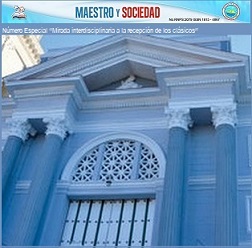The classic resource in Santiago periodicals: an interdisciplinary approach
Array
Keywords:
Armando Leyva Balaguer, literary heritage, classic letters, El Cubano Libre, Diario de Cuba, Santiago de CubaAbstract
The integration of content through interdisciplinary relationships in the teaching-learning process, allows progress in the construction and improvement of new knowledge in the area of humanistic sciences. This educational endeavor enables the professional training of the Literature career from the acquisition of knowledge during undergraduate teaching and its application, later, during the exercise of the profession. The present investigation establishes links and interconnections between the literary production of Armando Leyva Balaguer (1888-1942) and the assumption of significant aspects that show the classical influence in some of his texts, which appeared in periodical publications in Santiago. In this sense, we work with literary texts that today constitute a valuable source, treasured in the Rare and Valuable Funds room of the Elvira Cape Provincial Library in the city of Santiago de Cuba, due to the growing need for rescue and preservation of these publications and the work carried out by representative authors from the region. It also constitutes a bibliographic material that enriches the studies of Literatures and Cultures of Ibero-America and the Caribbean, as well as the discipline of Classic Letters.
References
2. Cabrera O.,Y.(2017). Letras Clásicas y Prática Pre-Profesional. Aproximación interdisciplinar de la práctica educativa desde el aula en Revista Convocación, 33-34,pp.32-37.
3. Hernández R., C. A., et al. (2017). Interdisciplinariedad: un desafío para transformar la universidad en el siglo XXI. Colombia: Programa Editorial.
4. I.L.L (2002). Historia de la Literatura Cubana. T. II. La Habana: Instituto Cubano del Libro.
5. Jiménez D., J. Nuevos métodos en la enseñanza del latín. Disponible en http//studylib.es/doc/5149676/.
6. Leyva B., A. (1923). Música de Grieg en El Cubano Libre (76) p. 2. Santiago de Cuba: Fondos Raros y Valiosos de Biblioteca Provincial Elvira Cape.
7. Leyva B., A. (1925). Un Caso en Diario de Cuba. Santiago de Cuba: Fondos Raros y Valiosos de Biblioteca Provincial Elvira Cape.
8. Leyva B., A. (1925). Cuanto vale la belleza en Diario de Cuba (tercera sección) p.3. Santiago de Cuba: Fondos Raros y Valiosos de Biblioteca Provincial Elvira Cape.
9. Miraglia, L. (2010). La enseñanza del Latín a lo largo de los siglos. Recuperado de http://www.culturaclasica.com/lingua latina.pdf.
10. Pérez, M. (). Breve incursión al fondo Armando Leyva en el centenario de su nacimiento en Anuario L/L (19), p. 102-118. La Habana: Instituto de Literatura y Lingüística.
11. Ferrer T., L. M. (2015). Aproximación al estudio de El Álbum (1891-1892) revista cultural y literaria de Santiago de Cuba en la etapa colonial. (Trabajo de diploma). Universidad de Oriente, Santiago de Cuba, Cuba
12. Ferrer T., L. M. (2017). El deporte en una revista cultural del siglo XIX en Santiago de Cuba. Revista Arrancada, 17(31), 38-42.
13. Fleitas V., I. (2015). Aproximación al estudio de Ilustración Cubana (1906): revista cultural y literaria de Santiago de Cuba en la etapa republicana. (Trabajo de diploma). Universidad de Oriente, Santiago de Cuba, Cuba.
14. Ramírez C., R.; Cabrera O., Y.; García T., Y. (2016). Las publicaciones periódicas de la Colección Cubana de la Biblioteca Provincial Elvira Cape: patrimonio literario de la ciudad de Santiago de Cuba. Publicando, 3, 485-498.
15. Ramírez C., R. A. (2016). La lírica santiaguera en la etapa republicana (1902-1923). Revista Chilena de Literatura, 92, 201-220.
Downloads
Published
How to Cite
Issue
Section
License
This journal provides immediate open access to its content, based on the principle that offering the public free access to research helps a greater global exchange of knowledge. Each author is responsible for the content of each of their articles.



























 Universidad de Oriente
Universidad de Oriente 